View in other NatureServe Network Field Guides
NatureServe
Montana
Utah
Wyoming
Idaho
Wisconsin
British Columbia
South Carolina
Yukon
California
New York
Sauger - Sander canadensis
State Rank Reason (see State Rank above)
The Sauger is currently listed as an "S2" species of concern in Montana because they are at risk of extirpation in the state, because of limited and/or declining numbers, range and/or habitat, even though it may be abundant in some areas. Population losses from the reservoir sections of the Missouri River and the Bighorn River are likely permanent. Competition and hybridization from the introduced walleye is another threat to native sauger populations.
General Description
The Sauger is one of two native percid species to Montana east of the Continental Divide closely resembling the introduced walleye. It inhabits both large rivers and reservoirs, but is mainly a river fish. In the spring, Sauger broadcast their spawn over riffles in rivers. Sauger are a highly prized sport fish and in some areas outside Montana are also commercially fished. Their major food items are insects and small fish.
For a comprehensive review of the ecology, conservation status, threats, and management of this and other Montana fish species of concern, please see
Montana Chapter of the American Fisheries Society Species of Concern Status Reviews.Diagnostic Characteristics
One of the most important features to differentiate sauger from walleye is the spotted dorsal fin, which has a spiny appearance. Sauger jaws and the roof of the mouth have large canine teeth. The body is almost round in cross section. The anal fin has 2 spines and 11 to 14 (usually 12 or 13) soft rays. The body often has a grayish hue with dark blotches.
Species Range
Montana Range
Range Descriptions
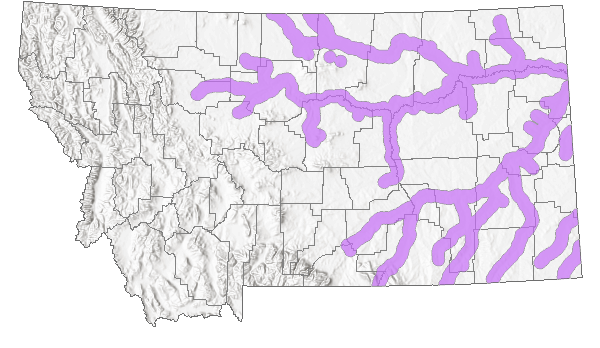
 Native
Native
Western Hemisphere Range
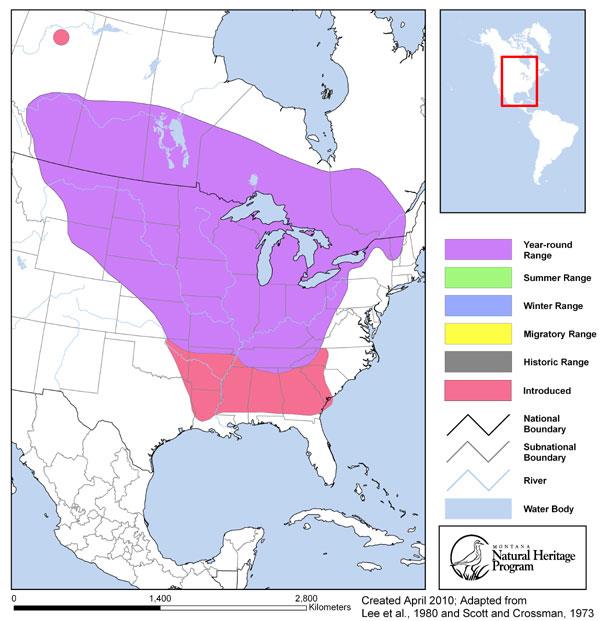
Range Comments
Sauger are one of the most widely distributed North American fishes with a historical range extending across most of central and eastern North America from the St. Lawrence-Champlain system south, west of the Appalachian Mountains, to the Tennessee River in Alabama, and northwestward to central Montana and Alberta (Scott and Crossman 1973). In Montana, historical distribution included the Missouri River and its major tributaries downstream of Great Falls and the Yellowstone River and its major tributaries downstream of the Clark Fork (McMahon and Gardner 2001). Current distribution in Montana has declined by 53% from historical levels with the largest losses occurring in tributaries (McMahon and Gardner 2001). Current distribution in the Missouri River drainage is confined to the mainstem Missouri and small parts of the previously widely occupied Marias, Musselshell, and Milk rivers
Observations in Montana Natural Heritage Program Database
Number of Observations: 1380
(Click on the following maps and charts to see full sized version)
Map Help and Descriptions
Relative Density
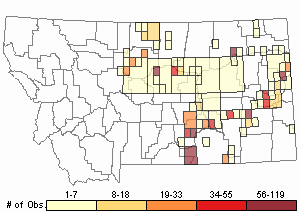
Recency
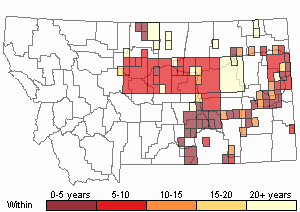
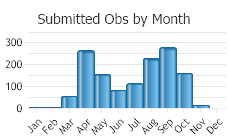
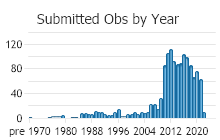
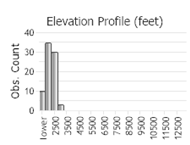 (Observations spanning multiple months or years are excluded from time charts)
(Observations spanning multiple months or years are excluded from time charts)
Migration
Spawning is often accompanied by migration upstream and/or into tributary streams in the spring. Long migration occurs in the Yellowstone and Missouri rivers.
Habitat
Sauger inhabit the larger turbid rivers and the muddy shallows of lakes and reservoirs. They spawn in gravelly or rocky areas in shallow water and seem to prefer turbid water.
Food Habits
The young eat aquatic insects and crustaceans. Adults feed mainly on fish. The very young feed on zooplankton. Young-of-the-year in the Missouri River are largely piscivorous.
Ecology
A large, vital spawning and feeding migration has been observed to occur from the lower reaches of the middle Missouri River to an area between Fort Benton and Morony Dam. The Tongue and Powder rivers are vital spawning areas for the Yellowstone River population.
Reproductive Characteristics
Sauger spawn from mid-April to May at water temperatures of 50 degrees F., with peaks early in May in a middle Missouri River study. They are sexually mature at 3 to 4 years. Eggs are cast over the bottom and incubate in 12 to 18 days at 50 degrees F.
Threats or Limiting Factors
Angler harvest, channelization, water flow fluctuations, migration barriers, loss of spawning and rearing habitat, and environmental degradation have resulted in declines in distribution and abundance of sauger populations rangewide (Rawson and Scholl 1978, Hesse 1994, Pegg et al. 1997). Similar factors have been implicated in the declines observed in Montana. Habitat loss and the presence of migratory barriers (i.e. dams, diversions) are the primary causes of the reduced distribution of sauger in Montana.
References
- Literature Cited AboveLegend:
 View Online Publication
View Online Publication Lee, D.S., C.R. Gilbert, C.H. Hocutt, R.E. Jenkins, D. E. McAllister, J. R. Stauffer, Jr. 1980. Atlas of North American freshwater fishes. North Carolina State Musuem of Natural History. 867 p.
Lee, D.S., C.R. Gilbert, C.H. Hocutt, R.E. Jenkins, D. E. McAllister, J. R. Stauffer, Jr. 1980. Atlas of North American freshwater fishes. North Carolina State Musuem of Natural History. 867 p. Scott, W.B. and E.J. Crossman. 1973. Rainbow trout, Kamloops trout, Steelhead trout Salmo gairdneri Richardson. pp. 184-191. In: Freshwater fishes of Canada. Ottawa, Canada: Fisheries Research Board of Canada, Bulletin 184. 966 p.
Scott, W.B. and E.J. Crossman. 1973. Rainbow trout, Kamloops trout, Steelhead trout Salmo gairdneri Richardson. pp. 184-191. In: Freshwater fishes of Canada. Ottawa, Canada: Fisheries Research Board of Canada, Bulletin 184. 966 p.
- Additional ReferencesLegend:
 View Online Publication
View Online Publication
Do you know of a citation we're missing? Bellgraph, B.J. 2006. Competition potential between Sauger and Walleye in non-native sympatry: historical trends and resource overlap in the middle Missouri River, Montana. M.Sc. Thesis. Bozeman, MT: Montana State University. 83 p.
Bellgraph, B.J. 2006. Competition potential between Sauger and Walleye in non-native sympatry: historical trends and resource overlap in the middle Missouri River, Montana. M.Sc. Thesis. Bozeman, MT: Montana State University. 83 p. Billington, N. 2006. Montana Sauger Genetic Characteristics. Final Project Performance Report.
Billington, N. 2006. Montana Sauger Genetic Characteristics. Final Project Performance Report. Billington, N., N. Koigi, B. Sloss, R.P. Franckowiak, and J. Xiong. 2006. Genetic variation and Hybridization with Walleye in Montana Sauger Populations Determined by Protein Electrophoresis and Microsatellite Analysis.
Billington, N., N. Koigi, B. Sloss, R.P. Franckowiak, and J. Xiong. 2006. Genetic variation and Hybridization with Walleye in Montana Sauger Populations Determined by Protein Electrophoresis and Microsatellite Analysis. Craig, V.E. 1952. A story of fish production as it applies to Montana. M.Sc. Thesis. Bozeman, MT: Montana State University. 92 p.
Craig, V.E. 1952. A story of fish production as it applies to Montana. M.Sc. Thesis. Bozeman, MT: Montana State University. 92 p. Dieterman, D.J., M.P. Ruggles, M.L. Wildhaber, and D.L. Galat (eds). 1996. Population structure and habitat use of benthic fishes along the Missouri and Lower Yellowstone Rivers. 1996 Annual report of Missouri River Benthic Fish Study PD-95-5832 to U.S. Army Corps of Engineers and U.S. Bureau of Reclamation. 238 p.
Dieterman, D.J., M.P. Ruggles, M.L. Wildhaber, and D.L. Galat (eds). 1996. Population structure and habitat use of benthic fishes along the Missouri and Lower Yellowstone Rivers. 1996 Annual report of Missouri River Benthic Fish Study PD-95-5832 to U.S. Army Corps of Engineers and U.S. Bureau of Reclamation. 238 p. Dockery, D.R. 2015. Relationships among swimming performance, water velocity, temperature, and body size for Sauger Sander canadadensis and Longnose Dace Rhinichthys cataractae. M.Sc. Thesis. Bozeman, MT: Montana State University. 126 p.
Dockery, D.R. 2015. Relationships among swimming performance, water velocity, temperature, and body size for Sauger Sander canadadensis and Longnose Dace Rhinichthys cataractae. M.Sc. Thesis. Bozeman, MT: Montana State University. 126 p. Dockery, D.R., T.E. McMahon, and M. Blank. 2017. Swimming performance of Sauger (Sander canadensis) in relation to fish passage. 74(12): 20135-2044.
Dockery, D.R., T.E. McMahon, and M. Blank. 2017. Swimming performance of Sauger (Sander canadensis) in relation to fish passage. 74(12): 20135-2044. Duncan, M.B. 2019. Distributions, abundances, and movements of small, nongame fishes in a large Great Plains river network. Ph.D. Dissertation. Bozeman, MT: Montana State University. 255 p.
Duncan, M.B. 2019. Distributions, abundances, and movements of small, nongame fishes in a large Great Plains river network. Ph.D. Dissertation. Bozeman, MT: Montana State University. 255 p. Great Falls Tribune. Yellowstone 'saugeye' sets record. Great Falls, MT: Great Falls Tribune. 21 April 1988. p. 1B.
Great Falls Tribune. Yellowstone 'saugeye' sets record. Great Falls, MT: Great Falls Tribune. 21 April 1988. p. 1B. Holton, G.D. 1981. Identification of Montana's most common game and sport fishes. Montana Outdoors May/June reprint. 8 p.
Holton, G.D. 1981. Identification of Montana's most common game and sport fishes. Montana Outdoors May/June reprint. 8 p. Jaeger, M.E. 2004. An empirical assessment of factors precluding recovery of sauger in the lower Yellowstone River: movement, habitat use, exploitation, and entrainment. M.Sc. Thesis. Bozeman, MT: Montana State University. 115 p.
Jaeger, M.E. 2004. An empirical assessment of factors precluding recovery of sauger in the lower Yellowstone River: movement, habitat use, exploitation, and entrainment. M.Sc. Thesis. Bozeman, MT: Montana State University. 115 p. Joslin, Gayle, and Heidi B. Youmans. 1999. Effects of recreation on Rocky Mountain wildlife: a review for Montana. [Montana]: Montana Chapter of the Wildlife Society.
Joslin, Gayle, and Heidi B. Youmans. 1999. Effects of recreation on Rocky Mountain wildlife: a review for Montana. [Montana]: Montana Chapter of the Wildlife Society. McDonald, K. 2003. Sauger telemetry in the Powder and Tongue Rivers. Project Performance Report. February 23, 2003 through December 31, 2003.
McDonald, K. 2003. Sauger telemetry in the Powder and Tongue Rivers. Project Performance Report. February 23, 2003 through December 31, 2003. Megargle, D.J. 1997. Temporal variation in food selection of shovelnose sturgeon in the Missouri River above Fort Peck Reservoir, MT. M.Sc. Thesis. Bozeman, MT: Montana State University. 127 p.
Megargle, D.J. 1997. Temporal variation in food selection of shovelnose sturgeon in the Missouri River above Fort Peck Reservoir, MT. M.Sc. Thesis. Bozeman, MT: Montana State University. 127 p. Montana Department of Fish, Wildlife and Parks. 1989. Northeast Montana Warmwater Ecosystem Investigations: project period 7/1/88 through 6/30/89. Proj.# F-46-R-2; Job# V-e. 21p.
Montana Department of Fish, Wildlife and Parks. 1989. Northeast Montana Warmwater Ecosystem Investigations: project period 7/1/88 through 6/30/89. Proj.# F-46-R-2; Job# V-e. 21p. Mullins, M.S. 1991. Biology and predator use of cisco (Coregonus artedi) in Fort Peck Reservoir, Montana. M.Sc. Thesis. Bozeman, MT: Montana State University. 68 p.
Mullins, M.S. 1991. Biology and predator use of cisco (Coregonus artedi) in Fort Peck Reservoir, Montana. M.Sc. Thesis. Bozeman, MT: Montana State University. 68 p. Penkal, R.F. 1977. Black bass populations of the Tongue River Reservoir, Montana. M.Sc. Thesis. Bozeman, MT: Montana State University. 111 p.
Penkal, R.F. 1977. Black bass populations of the Tongue River Reservoir, Montana. M.Sc. Thesis. Bozeman, MT: Montana State University. 111 p. Riggs, V.L. 1978. Age and growth of Walleye and Sauger of the Tongue River Reservoir, Montana. M.Sc. Thesis. Bozeman, Montana: Montana State University. 53 p.
Riggs, V.L. 1978. Age and growth of Walleye and Sauger of the Tongue River Reservoir, Montana. M.Sc. Thesis. Bozeman, Montana: Montana State University. 53 p. Stash, S.W. 2001. Distribution, relative abundance, and habitat associations of Milk River fishes related to irrigation diversion dams. M.Sc. Thesis. Bozeman, MT: Montana State University. 82 p.
Stash, S.W. 2001. Distribution, relative abundance, and habitat associations of Milk River fishes related to irrigation diversion dams. M.Sc. Thesis. Bozeman, MT: Montana State University. 82 p. Stringer, A.L. 2018. Status of Northern Pearl Dace and chrosomid dace in prairie streams of Montana. M.Sc. Thesis. Bozeman, MT: Montana State University. 150 p.
Stringer, A.L. 2018. Status of Northern Pearl Dace and chrosomid dace in prairie streams of Montana. M.Sc. Thesis. Bozeman, MT: Montana State University. 150 p. Trenka, R.J. 2000. Community structure and habitat associations of fishes of the lower Tongue and Powder Rivers. M.Sc. Thesis. Bozeman, MT: Montana State University. 85 p.
Trenka, R.J. 2000. Community structure and habitat associations of fishes of the lower Tongue and Powder Rivers. M.Sc. Thesis. Bozeman, MT: Montana State University. 85 p. USDI Bureau of Land Management. No date. Fishes of the Miles city, Montana BLM District. Miles City, MT: Miles City BLM District pamphlet. 12 p.
USDI Bureau of Land Management. No date. Fishes of the Miles city, Montana BLM District. Miles City, MT: Miles City BLM District pamphlet. 12 p. Wuellner, M.R. 2007. Influence of reach and watershed characteristics on fish distributions in small streams of eastern Montana. M.Sc. Thesis. Bozeman, MT: Montana State University. 80 p.
Wuellner, M.R. 2007. Influence of reach and watershed characteristics on fish distributions in small streams of eastern Montana. M.Sc. Thesis. Bozeman, MT: Montana State University. 80 p. Young, B.A., T.L. Welker, M.L. Wildhaber, C.R. Berry, and D. Scarnecchia (eds). 1997. Population structure and habitat use of benthic fishes along the Missouri and Lower Yellowstone Rivers. 1997 Annual report of Missouri River Benthic Fish Study PD-95-5832 to U.S. Army Corps of Engineers and U.S. Bureau of Reclamation. 207 p.
Young, B.A., T.L. Welker, M.L. Wildhaber, C.R. Berry, and D. Scarnecchia (eds). 1997. Population structure and habitat use of benthic fishes along the Missouri and Lower Yellowstone Rivers. 1997 Annual report of Missouri River Benthic Fish Study PD-95-5832 to U.S. Army Corps of Engineers and U.S. Bureau of Reclamation. 207 p.
- Web Search Engines for Articles on "Sauger"
- Additional Sources of Information Related to "Fish"





